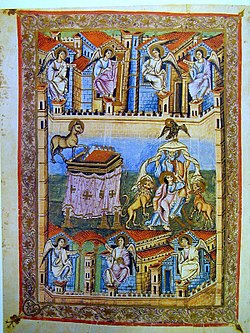
Back Openbaring Afrikaans የዮሐንስ ራዕይ Amharic Ontynung ANG رؤيا يوحنا Arabic ܓܠܝܢܐ ܕܝܘܚܢܢ ARC رؤيا يوحنا ARZ Apocalipsis AST Vəhy Kitabı Azerbaijani Offnbarung vom Johannes BAR Buku Pangungkapon BBC
| Part of a series on |
| Books of the New Testament |
|---|
 |
| Part of a series of articles on |
| John in the Bible |
|---|
 |
| Johannine literature |
| Authorship |
| Related literature |
| See also |
| Christian eschatology |
|---|
| Christianity portal |


The Book of Revelation or Book of the Apocalypse is the final book of the New Testament (and therefore the final book of the Christian Bible). Written in Koine Greek, its title is derived from the first word of the text: apokalypsis, meaning 'unveiling' or 'revelation'. The Book of Revelation is the only apocalyptic book in the New Testament canon.[a] It occupies a central place in Christian eschatology.
The author names himself as simply "John" in the text, but his precise identity remains a point of academic debate.[b]
The book spans three literary genres: the epistolary, the apocalyptic, and the prophetic.[7] It begins with John, on the island of Patmos in the Aegean Sea, addressing letters to the "Seven Churches of Asia" with exhortations from Christ. He then describes a series of prophetic and symbolic visions, including figures such as a Woman clothed with the sun with the moon under her feet and a crown of twelve stars, the Serpent, the Seven-Headed Dragon, and the Beast, which culminate in the Second Coming of Jesus.
The sometimes obscure and extravagant imagery, with many Old Testament allusions and numeric symbolism, has allowed a wide variety of Christian interpretations.
Cite error: There are <ref group=lower-alpha> tags or {{efn}} templates on this page, but the references will not show without a {{reflist|group=lower-alpha}} template or {{notelist}} template (see the help page).
- ^ Carson, Don (2005). An Introduction to the New Testament (2nd ed.). Grand Rapids, Michigan: Zondervan. pp. 465ff. ISBN 978-0-310-51940-9.
- ^ Holmes, Michael (2007). The Apostolic Fathers: Greek Texts and English Translations. Baker Academic. p. 749ff. ISBN 978-0801034688.
- ^ Collins 1984, p. 28.
- ^ Bauckham 1993, p. 2.
- ^ Stuckenbruck 2003, pp. 1535–1536.
- ^ Behr, John (2019). John the Theologian and his Paschal Gospel. Oxford: Oxford University Press. ISBN 978-0-19-257444-2.
- ^ Stuckenbruck 2003, p. 1536.
© MMXXIII Rich X Search. We shall prevail. All rights reserved. Rich X Search